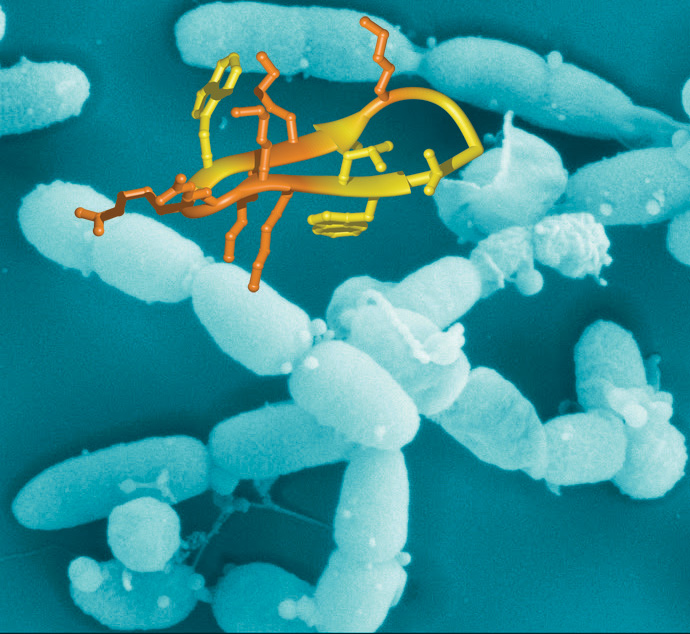Medicine has lost ground in race against germs
Thomas was healthy and loved his job until he learned the hard way that antibiotics might stop working. He became unable to work and took weeks to recover. The cause? Multi-resistant germs that are increasingly becoming a threat – even in the modern world.
It all started with a minor cough. As it worsened over the next days, IT specialist Thomas* went to see his general practitioner. “He diagnosed an atypical pneumonia,” Thomas recalls. When the inflammatory values visibly deteriorated, the doctor prescribed an antibiotic.
“But even after five days there was no improvement – on the contrary,” Thomas said. So he had to stay in bed with a high fever for weeks. “Eventually the doctor switched the antibiotic and the values improved two days later.”
Not all patients are that lucky. Every year, rising numbers of people die due to antibiotic resistance – an estimated 25,000 in the European Union. That is why countries and organisations like the World Health Organization (WHO) have started developing strategies to monitor antibiotic use and tackle the problem.
In human and veterinary medicine, including livestock farming, antibiotics can be used improperly; too frequently, in the wrong dosage or as an means to – ineffectively – fight viral infections, which means that bacteria are not fully killed off. As a result some bacteria survive and have time to develop resistance.
“We already have isolated deaths in Switzerland because patients could no longer be treated due to resistance,” said Andreas Kronenberg of the Institute for Infectious Diseases at the University of Bern. The infectious disease specialist is head of the Swiss Centre for Antibiotic ResistanceExternal link.
Negligent use
For Annelies Zinkernagel, a senior physician for Infectious Diseases at the University Hospital in Zurich, also says the largest threat comes from so-called “gram negative” germs, which are resistant to a multitude of antibiotics. They are spreading because of the heavy use of antibiotics in animal farming and the over-the-counter availability of antibiotics as well as an excessive and incorrect usage of drugs.
“We are selective and extremely stringent with the use of antibiotics in order to avoid further resistance development and preserve the normal microflora,” Zinkernagel explains. “But many travellers coming from India, for example, are literally colonised with resistant bacteria.”
People with a compromised immune system are most at risk, but the carriers of the germs are often healthy people like travellers. That is why Zinkernagel stresses the importance of antibiotic stewardship programmes that promote a better drug use, hygiene measures like disinfection as well as prevention through vaccination.
Switzerland in the midfield
Antibiotic resistance is spreading worldwide “in an epidemic manner”, according to the antibiotic resistance centre’s website. “There is no overall figure,” Kronenberg says. “You always have to differentiate which micro-organism and which antibiotic you are looking at.”
The rate of intestinal Escherichia coli (E. coli) that produce the resistance enzyme called extended-spectrum beta-lactamase (ESBL), which makes the bacteria no longer respond to even to newer antibiotics, is increasing by 1% every year in Switzerland.
“In other countries the rates are even more pronounced. In India the occurrence of this resistance is at about 80%.” This means that the drugs are only effective in one of five patients.
Now the Swiss government is proposing a national strategy to fight antibiotic resistanceExternal link, which is backed by several federal offices. The ultimate goal is to preserve the effectiveness of antibiotics for humans and animals in the long-term.
The idea is to “get all parties involved in the issue on board and not just look at human or veterinary medicine in an isolated manner”, Kronenberg said. One has to get away from blaming each other. The goal is to protect the population, to prevent transmission in hospitals and the spread within the country, he said.
“That is where you can achieve a lot,” Kronenberg is convinced. “A central measure is the cross-sectional monitoring of resistance and the use of antibiotics in human medicine, veterinary medicine, agriculture and the environment,” the government writes in its strategy.
The proposals are currently being reviewed by interested parties in a consultation process, after which the strategy’s wording will be finalised and adopted by the cabinet.
WHO report
There are worldwide efforts being undertaken to tackle the problem. In 2014, the WHO published its most comprehensive report on antimicrobial resistanceExternal link, which showed that resistance to common bacteria has reached alarming levels in many parts of the world.
At the 68th World Health Assembly in May 2015, the WHO will propose a global action plan to fight the spread of resistances, which threaten to quash many of the medical breakthroughs of the last century and would have devastating implications.
“Without urgent, coordinated action the world is headed for a post-antibiotic era, in which common infections and minor injuries which have been treatable for decades can once again kill,” warned Keiji Fukuda, the WHO’s Assistant Director-General for Health Security.
The authors of the report, who included data from 114 countries, are particularly concerned about resistances to so-called antibiotics of last resort, which in many parts of the world fail to work in a majority of the people infected.
Carbapenem antibiotics for example are increasingly ineffective against life-threatening hospital-acquired infections caused by intestinal bug Klebsiella pneumoniae, and resistance to fluoroquinolones to treat E. coli infections is also very widespread, the WHO warns.
The WHO recommends that antibiotics be prescribed only when necessary, and that patients finish the prescribed doses even if symptoms improve. It also calls for a system to track and monitor resistance, better hygiene to prevent infection and research into new therapies. The last point, however, is quite tricky.
Little incentive
There are numerous reasons why many pharmaceutical companies have discontinued research and development into new antibiotics over the past years, according to Sara Käch, spokeswoman at pharmaceutical lobby organisation InterpharmaExternal link.
“In the interest of public health, antibiotics should only be prescribed in a very limited manner, which weighs on profits,” Käch explains. “In addition, patient populations are also relatively small, and varied antibiotics with different mechanisms are needed to fight the same bacteria.”
Multiple resistance is a very complex scientific challenge. “But over the past years we have seen a number of initiatives from companies and public entities.” One example is the New Drugs 4 Bad Bugs initiativeExternal link, supported by the European Commission and the industry.
The researchers said they launched that project because only two new classes of antibiotics have been brought to market in the past 30 years. Another more recent European project to promote antibiotics research is DRIVE-ABExternal link.
So there is hope that there will be new treatments eventually. In January, German and US scientists announced that they have discovered a new natural antibiotic, teixobactin, to beat superbug resistance. This experimental drug is expected to take five to ten years to reach the market.
“It’s not just that antibiotics fail to offer a top potential for value creation, but there is a time lag because the industry needs a certain time to develop new products,” said Marcel Sennhauser from business association ScienceindustriesExternal link. “As a result, developing new drugs becomes more challenging because of tougher regulatory requirements and because bacteria have meanwhile evolved.”
In addition, in the western world there is a lack of awareness among the general population about what bacteria are capable of – and little willingness to pay the price, Sennhauser explained. “Most people believe everything is under control. They are not aware of the danger in the same way as the people who work at the hospitals.”
As a patient, Thomas knows all about the dangers. But today, he even manages to see some positive aspects to his antibiotics odyssey. “My illness made me lose eight kilograms,” he said with a laugh, “but within a year, I put all the weight back on.”
(*Not real name)
Lifesavers
The first synthetic antibiotic was the syphilis treatment arspenamine, which was discovered in 1907. In 1928, it was noticed that the fungus penicillin can kill bacteria. Derivatives of this first natural antibiotic are still widely used today, but many bacteria no longer respond.
Since around 1910, effective antibiotics have been one of the pillars allowing us to live longer and healthier. Antimicrobial resistance threatens the effective prevention and treatment of an increasing range of infections caused by bacteria, parasites, viruses and fungi.
Resistant bacteria may cause common infections such as urinary tract infections, pneumonia, bloodstream infections, diarrhoea and gonorrhoea. Methicillin-resistant Staphylococcus aureus (MRSA) or multidrug-resistant bacteria may cause hospital-acquired infections. Antibiotic resistance makes people sicker for longer and raises the risk of death. People with MRSA, for example, are 64% more likely to die than people with a non-resistant form. Resistance also raises healthcare costs with lengthier hospital stays and more intensive care.
(Source: WHO)
Human and veterinary medicine are linked
Resistance to antibiotics is a problem with potential links between human and veterinary medicine. According to the University of Bern, these links have not really been investigated. Bacteria can be transmitted between animals and humans through direct or indirect contact (for example, salmonella in food). Resistant bacteria isolated in livestock are very similar to those causing major problems in human medicine.
“Microbiological investigations in animals are therefore not only important for the health and well-being of animals, but also those of human beings,” the researchers write.
(Source: University of Bern)

In compliance with the JTI standards
More: SWI swissinfo.ch certified by the Journalism Trust Initiative











You can find an overview of ongoing debates with our journalists here . Please join us!
If you want to start a conversation about a topic raised in this article or want to report factual errors, email us at english@swissinfo.ch.